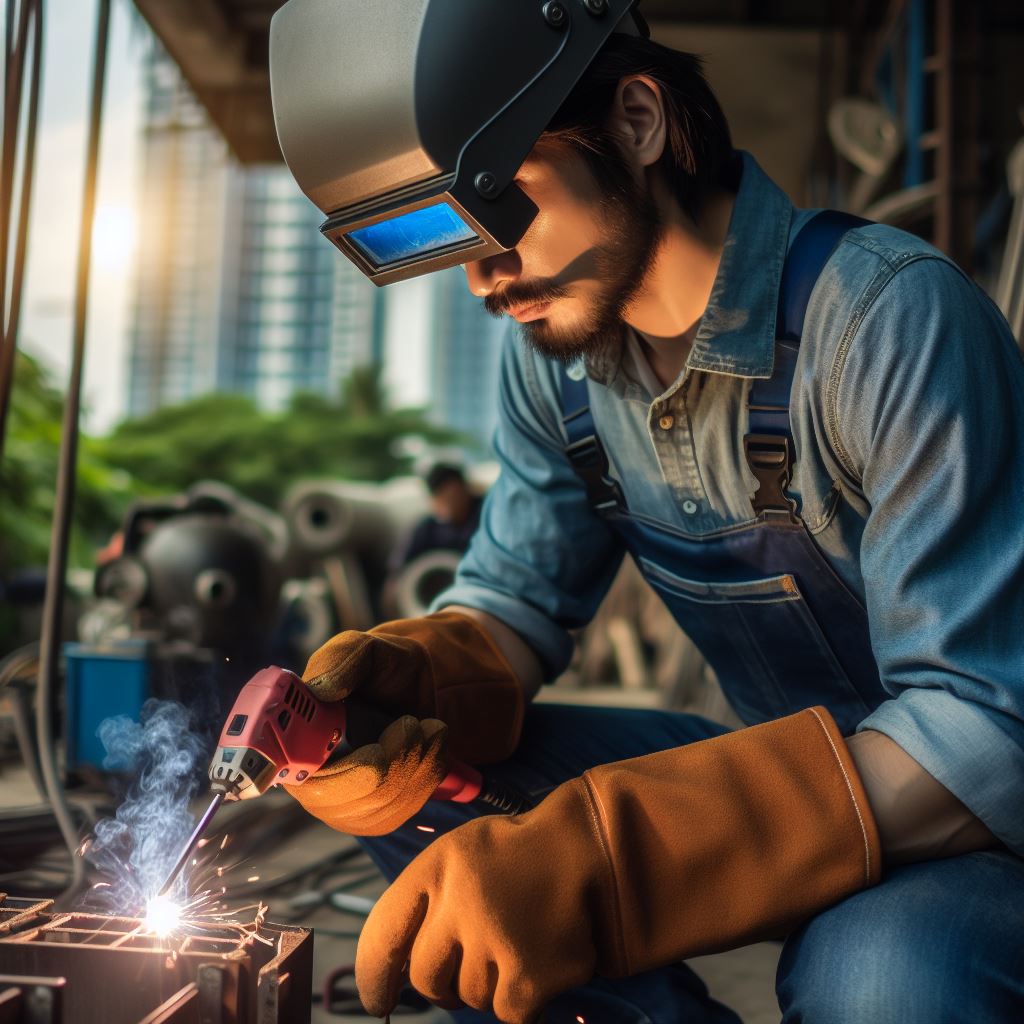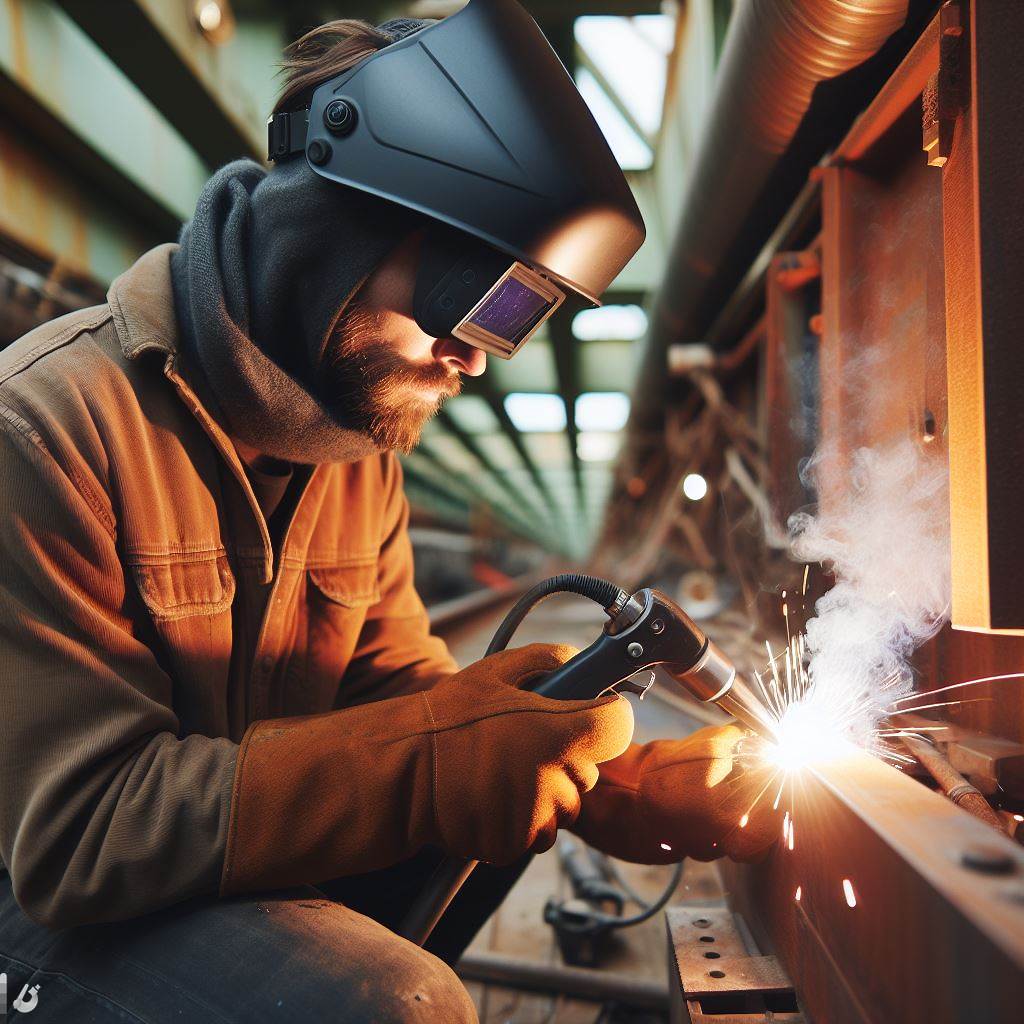Introduction
Welding jobs in Australia play a crucial role in several industries, ensuring the construction and maintenance of essential structures. Currently, the state of welding jobs in the country is significant, with a high demand for skilled welders.
In this blog section, we will explore future trends and statistics that will impact the industry.
Welding is an indispensable skill set in Australia, as it contributes to the development of various sectors such as infrastructure, manufacturing, and resources.
The need for welding professionals is evident in the construction of buildings, bridges, pipelines, and even in shipbuilding projects. Without skilled welders, these projects would not be possible.
Currently, welding jobs in Australia are in high demand. With ongoing infrastructure projects and advancements in technology, the need for skilled welders continues to grow.
There is a shortage of qualified individuals in the field, resulting in excellent employment opportunities for aspiring welders.
Looking into the future, several trends and statistics are worth considering. For example, the rise of automation and robotics in welding processes will change the nature of the job, requiring welders to adapt to new technologies.
Additionally, the importance of safety training and certifications will increase to ensure both worker safety and high standards of work.
In this blog post, we will delve into these future trends and statistics, analyzing their impact on the welding job market.
By understanding these developments, both aspiring and current welders can make informed decisions about their careers, ensuring success in the ever-evolving field of welding in Australia.
The Growing Demand for Welders in Australia
Welding is a critical skill that has always been in demand across various industries. However, in recent years, the need for welders in Australia has been increasing at a significant rate.
This growing demand can be attributed to several factors that contribute to the growth in the welding industry.
Increasing Need for Welders in Various Industries
One of the primary reasons for the growing demand for welders is the expanding construction industry in Australia.
With numerous infrastructure projects underway, including the construction of new buildings, bridges, and roads, there is a constant requirement for skilled welders to assist in the fabrication and assembly of structural components.
Additionally, the manufacturing sector in Australia heavily relies on welders for the production of goods.
From automotive manufacturing to aerospace and defense industries, welders play a crucial role in ensuring the quality and integrity of the products being manufactured.
Furthermore, the mining industry in Australia is another significant contributor to the demand for welders. The extraction and processing of minerals often require welding expertise for maintenance, repair, and even the construction of mining equipment.
Factors Contributing to the Growth in Demand
Several factors have led to the growth in demand for welders in Australia. Firstly, the retirement of experienced welders has created a skills gap that needs to be filled by a new generation of welders.
This demographic shift has opened up numerous opportunities for aspiring welders to enter the workforce.
Moreover, the advancements in technology and automation have not diminished the need for manual welding skills.
Instead, they have created new applications and requirements for welders, particularly in areas such as robotics and specialized welding techniques.
The increasing focus on infrastructure development and maintenance, particularly in regional areas, has also contributed to the growth in demand for welders.
As the government invests in upgrading and maintaining existing infrastructure, welders are needed to carry out necessary repairs and enhancements.
Relevant Statistics and Trends Showcasing the Demand for Welders
The statistics and trends in the welding industry further highlight the growing demand for welders in Australia.
According to the Australian Industry Skills Committee, the number of job openings for welders is projected to increase by 7.8% over the next five years.
Furthermore, the Australian Government’s Job Outlook website reports that there were over 18,500 welders employed in 2020, and this number is expected to grow by more than 10% by 2025.
The average weekly earnings of welders in Australia is also significant, with full-time welders earning approximately AUD$1,600 per week. This demonstrates the attractive earning potential and stability that welding jobs offer.
Your Personalized Career Strategy
Unlock your potential with tailored career consulting. Get clear, actionable steps designed for your success. Start now!
Get StartedOverall, the future of welding jobs in Australia appears promising, with a growing demand across various industries.
As the country continues to invest in infrastructure and industrial growth, welders will remain essential for maintaining and advancing Australia’s built environment.
Technological advancements in the welding industry
In recent years, the welding industry has witnessed significant technological advancements that are transforming the way welding jobs are performed.
These advancements have revolutionized various aspects of welding, including equipment, processes, and overall productivity.
Explanation of how technology is transforming the welding industry
Technology has played a crucial role in improving the efficiency and effectiveness of welding operations. Here are some key ways in which technology is transforming the welding industry:
- Enhanced welding equipment: Modern welding machines and tools are equipped with advanced features that allow for precise control and provide better welding results. These include features such as digital displays, adjustable settings, and improved power sources.
- Automation and robotics: Automation has become an integral part of the welding industry, leading to increased productivity and reduced labor costs. Automated systems, robotic arms, and welding robots are being widely employed to perform repetitive and complex welding tasks with great precision.
- Improved welding processes: Technology has led to the development of new and improved welding processes, such as laser welding, plasma arc welding, and electron beam welding. These processes offer higher welding speeds, better quality welds, and increased efficiency.
- Remote welding: With the advancements in communication technology, remote welding has become a reality. Welders can now operate welding equipment from a remote location, reducing the need for physical presence at the worksite.
- Welding simulation and virtual reality: Welding simulation software and virtual reality tools enable welders to practice their skills in a virtual environment. This allows them to gain experience and improve their welding techniques without the risk of damaging real materials.
The impact of automation, robotics, and artificial intelligence on welding jobs
The increasing use of automation, robotics, and artificial intelligence (AI) in the welding industry has had both positive and negative impacts on welding jobs.
On one hand, automation and robotics have led to increased productivity, improved precision, and reduced labor costs. Welding robots can work continuously without fatigue or errors, resulting in faster and more consistent welds.
This has significantly increased the overall efficiency and profitability of welding operations.
However, these advancements have also raised concerns about job displacement. As automation and robotics become more sophisticated, there is a risk that some traditional welding jobs may become obsolete.
Welders will need to adapt to this changing landscape by acquiring new skills that complement automated systems.
The skills that welders need to develop in order to adapt to these advancements
To remain relevant and thrive in the evolving welding industry, welders need to develop a range of skills that align with technological advancements. Here are some key skills welders should focus on:
- Programming and robotics: Understanding how to program and operate welding robots will be essential for welders to work alongside automated systems.
- Advanced welding techniques: Familiarity with advanced welding processes, such as laser welding and plasma arc welding, will help welders take advantage of these technologies and perform more specialized tasks.
- Computer skills: Proficiency in using computer software and welding simulation tools will enable welders to optimize welding parameters, perform virtual testing, and troubleshoot welding issues.
- Adaptability and continuous learning: With technology constantly evolving, welders need to embrace a mindset of lifelong learning and adaptability. Staying updated with the latest advancements and acquiring new skills will be crucial.
- Problem-solving and critical thinking: As welding processes become more complex, welders will need strong problem-solving and critical thinking skills to troubleshoot issues and make informed decisions.
In review, the welding industry in Australia is experiencing significant technological advancements that are transforming the way welding jobs are performed.
Automation, robotics, and artificial intelligence are revolutionizing the industry, increasing productivity and efficiency.
However, welders need to adapt to these advancements by developing skills in programming, advanced welding techniques, computer literacy, adaptability, and problem-solving.
By embracing these changes and continuously learning, welders can thrive in the future of welding jobs.
Read: A Day in the Life of an Aussie Plumber
Green welding and sustainable practices
Green welding refers to the adoption of environmentally friendly practices in the welding industry. With increasing concerns about climate change and the need for sustainable solutions, the importance of green welding cannot be overstated.
As industries across the globe are becoming more conscious of their environmental impact, the welding industry is also expanding its focus on sustainability.
It is crucial to minimize the carbon footprint and reduce pollution associated with welding processes.
One of the significant advantages of green welding is the reduction in energy consumption.
By utilizing energy-efficient welding equipment and techniques, it is possible to minimize the overall energy usage, leading to cost savings and reduced environmental impact.
The growing emphasis on sustainability in the welding industry
The growing emphasis on sustainability in the welding industry has resulted in the development of innovative technologies and practices. For example, there is an increasing use of renewable energy sources like solar power for welding operations.
Another aspect of green welding is the implementation of waste reduction strategies. Instead of discarding excess materials and resources, efforts should be made to recycle and reuse them.
This not only reduces waste but also conserves valuable resources.
Stand Out with a Resume That Gets Results
Your career is worth more than a generic template. Let us craft a resume and cover letter that showcase your unique strengths and help you secure that dream job.
Get HiredThe opportunities in green welding and the skills required for these roles
Green welding also involves the use of eco-friendly alternatives such as low-emission gases and non-toxic coatings.
These alternatives are not only better for the environment but also enhance worker safety by reducing exposure to harmful fumes and chemicals.
There are several opportunities for individuals interested in green welding. Companies are actively seeking professionals with knowledge and skills in sustainable welding practices.
These roles include waste reduction specialists, energy management consultants, and sustainable welding technicians.
Mastering Green Welding: Skills, Sustainability, and Thriving in a Growing Secto
To excel in green welding, individuals need to acquire specific skills. Knowledge of advanced welding techniques and familiarity with environmentally friendly equipment is essential.
Additionally, expertise in waste management, resource conservation, and renewable energy integration is highly valued.
Furthermore, staying updated with the latest industry trends and technologies is vital to thrive in the field of green welding. As sustainability continues to gain prominence, continuous learning and skill development are crucial for professionals.
Essentially, green welding and sustainable practices are gaining momentum in the welding industry. With increasing concerns about the environment, it has become essential to adopt environmentally friendly approaches in welding operations.
The opportunities in green welding are vast, and individuals with the necessary skills and knowledge can contribute significantly to this growing sector.
Read: The Future of Plumbing Tech in Australia
Uncover the Details: The Future of Carpentry in Australia
Job prospects and career opportunities for welders
Welding jobs in Australia offer promising career prospects and lucrative opportunities for individuals in this field. Let’s explore the statistics and data on the current job prospects for welders in the country.
Presentation of statistics and data on the current job prospects for welders in Australia
According to recent statistics, the demand for skilled welders in Australia is on the rise. The welding industry is projected to experience a significant growth rate in the coming years.
In 2020, there were approximately 64,000 welders employed across the country. This number is expected to increase by 8% over the next five years, resulting in around 69,000 welding jobs.
The average annual salary of a welder in Australia is around AUD 60,000, making it an appealing career option for many individuals. With experience and further specialization, welders can earn even higher wages.
Overview of the industries with the highest demand for welders
Various industries in Australia heavily rely on welders for their operations. Here are some sectors with the highest demand for skilled welders:
- Construction Industry: The construction sector requires welders for infrastructure development, including bridges, buildings, and pipelines.
- Manufacturing Industry: Manufacturing companies need welders to assemble and fabricate metal parts for machinery and equipment.
- Offshore and Marine Industry: Welders play a crucial role in the construction and maintenance of offshore platforms, ships, and other marine vessels.
- Mining Industry: The mining sector utilizes welding for repairs, maintenance, and construction of mining equipment and structures.
- Automotive Industry: Automotive manufacturers and repair shops employ welders to work on vehicles and their components.
Information on potential career growth and advancement opportunities in welding
Welding offers avenues for career growth and advancement based on experience, skills, and further education. Here are some opportunities for welders seeking to advance in their careers:
- Specialization: By focusing on specific welding techniques such as TIG (Tungsten Inert Gas) or MIG (Metal Inert Gas), welders can gain expertise and become highly sought after in their field.
- Supervisory Roles: With experience and leadership skills, welders can progress to supervisory or managerial positions, overseeing welding projects and teams.
- Inspection and Quality Control: Welders can transition into roles involving inspection and quality control, ensuring welding standards and certifications are met.
- Entrepreneurship: Experienced welders have the option to start their own welding businesses, catering to the growing demand in various industries.
- Teaching and Training: Welders can share their knowledge and expertise by becoming instructors or trainers, imparting their skills to the next generation of welders.
Moreover, welders can also consider pursuing further education and certifications to enhance their career prospects.
Specialized certifications like the International Welding Engineer (IWE) or Certified Welding Inspector (CWI) can open doors to higher-paying jobs and more significant responsibilities.
Transform Your LinkedIn for Maximum Impact
Elevate your professional brand with a LinkedIn profile that attracts recruiters, showcases your expertise, and maximizes opportunities. Stand out in your industry with a profile built for success.
Boost ProfileGenerally, the future of welding jobs in Australia appears bright, with increasing job prospects and numerous career opportunities.
This versatile field offers not only financial stability but also options for growth and advancement in various industries.
Aspiring welders should consider the demand, salary potential, and avenues for career progression to make informed decisions about their future in welding.
Read: Top Plumbing Trends in Australian Engineering

Delve into the Subject: Landscaping Tools: Must-Haves in Oz
Delve into the Subject: Starting a Landscaping Business Down Under
Delve into the Subject: Energy-Efficient Building in Australia Today
Training and Education for Future Welders
In order to succeed in the welding industry and secure a promising future, proper training and education are necessary.
Here is an explanation of why this is important, an overview of available programs and certifications, and the skills and qualifications that employers seek in welders.
Importance of Proper Training and Education
In the constantly evolving field of welding, staying updated with the latest techniques, technologies, and safety protocols is crucial.
Proper training and education provide aspiring welders with the necessary skills and knowledge to meet the industry’s demands.
Welding involves complex processes and specific equipment. Without adequate training, welders may lack the expertise to complete tasks accurately, efficiently, and safely.
A solid foundation built through education reduces the risk of errors, accidents, and injuries.
Overview of Available Training Programs and Certifications
In Australia, there are various training programs and certifications that aspiring welders can pursue.
Apprenticeships
- Many welders begin their journey through apprenticeship programs offered by trade schools or industry associations.
- Apprenticeships combine on-the-job training with classroom instruction, providing hands-on experience and theoretical knowledge.
TAFE Courses
- The Technical and Further Education (TAFE) institutes in Australia offer welding courses at various levels.
- These courses cover a wide range of welding techniques, metal types, safety procedures, blueprint reading, and welding codes and standards.
Vocational Education and Training (VET) Programs
- VET programs focus on practical skills and industry-specific knowledge.
- These programs often provide specialized training in specific welding processes, such as arc welding, TIG welding, and MIG welding.
Certifications
- Certifications validate a welder’s capabilities and expertise in specific welding processes or positions.
- The most widely recognized certification in Australia is the Weld Australia Certification, which covers various levels of proficiency.
Skills and Qualifications Employers Look For
When hiring welders, employers seek individuals who possess certain skills and qualifications.
Technical Skills
- Adept understanding of different welding techniques, such as MIG, TIG, and arc welding.
- Ability to read and interpret blueprints, welding symbols, and technical drawings.
- Proficiency in operating welding equipment and tools.
Experience
- Demonstration of previous work experience in a relevant welding role.
- Hands-on experience with various types of metals and welding processes.
- Proven track record of meeting project deadlines and delivering high-quality results.
Knowledge
- Understanding of welding codes, safety regulations, and industry standards.
- Familiarity with welding materials, their properties, and the appropriate welding techniques for each.
Attention to Detail
- Ability to perform precise welds with attention to aesthetic and structural qualities.
- Keen eye for identifying defects, faults, or irregularities in welding work.
Communication and Collaboration
- Effective communication skills to coordinate with team members and understand project requirements.
- Collaboration skills to work seamlessly with engineers, designers, and other professionals.
By acquiring these skills and qualifications, aspiring welders can enhance their employability and increase their chances of securing rewarding positions in the welding industry.
Read: How to Become a Plumber in Australia
See Related Content: Native Plants for Aussie Landscapers
Conclusion
We have discussed several key points regarding the future of welding jobs in Australia. We have seen that the demand for skilled welders is expected to rise in the coming years, creating ample opportunities for individuals in this field.
The advancements in technology and increasing investment in infrastructure development further support the promising future of welding jobs in Australia.
For those considering a career in welding, this is an encouraging time to pursue your passion. With the projected growth and job prospects, there is a high potential for both professional and financial success in this field.
Additionally, the diversity of industries that require welding expertise ensures a range of options for career specialization.
It is crucial to acquire the necessary skills and qualifications to succeed in the welding industry. Seek out reputable training programs and certifications that will equip you with the knowledge and practical experience needed to excel in this field.
Stay updated with the latest advancements in welding technology and techniques to stay competitive in the job market.
Lastly, the future of welding jobs in Australia looks promising. The demand for skilled welders will continue to grow, presenting numerous career opportunities. So, if you have a passion for welding, don’t hesitate to pursue it.
With the right training and dedication, a successful and fulfilling career in welding awaits you in Australia.




